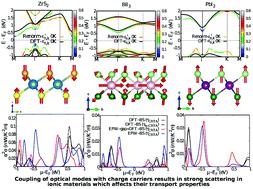当前位置:
X-MOL 学术
›
Phys. Chem. Chem. Phys.
›
论文详情
Our official English website, www.x-mol.net, welcomes your
feedback! (Note: you will need to create a separate account there.)
Effect of electron–phonon coupling on the transport properties of monolayers of ZrS2, BiI3 and PbI2: a thermoelectric perspective
Physical Chemistry Chemical Physics ( IF 2.9 ) Pub Date : 2021-4-22 , DOI: 10.1039/d1cp00533b Gautam Sharma 1, 2, 3, 4 , Vineet Kumar Pandey 1, 2, 3, 4 , Shouvik Datta 1, 2, 3, 4, 5 , Prasenjit Ghosh 1, 2, 3, 4, 5
Physical Chemistry Chemical Physics ( IF 2.9 ) Pub Date : 2021-4-22 , DOI: 10.1039/d1cp00533b Gautam Sharma 1, 2, 3, 4 , Vineet Kumar Pandey 1, 2, 3, 4 , Shouvik Datta 1, 2, 3, 4, 5 , Prasenjit Ghosh 1, 2, 3, 4, 5
Affiliation

|
Thermoelectric materials are used for the conversion of waste heat to electrical energy. The transport coefficients that determine their thermoelectric properties depend on the band structure and the relaxation time of the charge carriers. Both of these are significantly affected by electron–phonon coupling. In this work, using a combination of density functional theory and semiclassical Boltzmann transport theory, we have studied the effect of electron–phonon coupling in monolayers of ZrS2, BiI3 and PbI2. Our results show that in these ionic materials charge carriers are primarily scattered by the optical modes that strongly couple with them. From our study it is conclusively shown that neglecting the contributions of optical modes to electron–phonon coupling in these low-dimensional ionic solids, as is usually done in the computation of relaxation time from deformation theory, results in severe overestimation of the relaxation time. In particular, neglecting the scattering of the optical phonons results in about two orders of magnitude overestimation of relaxation times in these materials. Moreover, we also find that the renormalization of the band structure not only results in the reduction of band gaps but also changes the band dispersion, which strongly affect different transport properties like the electrical conductivity and Seebeck coefficient. Amongst these three materials, we observe that carrier relaxation time due to electron–phonon scattering is reduced as the ionicity of the material decreases.
中文翻译:

电子-声子耦合对ZrS2,BiI3和PbI2单层输运性质的影响:热电观点
热电材料用于将废热转化为电能。确定其热电特性的传输系数取决于带结构和电荷载流子的弛豫时间。两者都受到电子-声子耦合的显着影响。在这项工作中,使用密度泛函理论和半经典玻尔兹曼输运理论的组合,我们研究了在ZRS的单层电子-声子耦合的效果2,BII 3和碘化铅2。我们的结果表明,在这些离子材料中,电荷载流子主要被与其强烈耦合的光学模式散射。从我们的研究中可以得出结论,忽略光学模式对这些低维离子固体中电子-声子耦合的贡献,这通常是根据变形理论计算驰豫时间的结果,从而导致对驰豫时间的严重高估。特别地,忽略光学声子的散射会导致这些材料中弛豫时间的高估大约两个数量级。此外,我们还发现能带结构的重新规范化不仅会导致带隙的减小,而且会改变带的色散,这会严重影响不同的传输特性,例如电导率和塞贝克系数。在这三种材料中,我们观察到由于材料的离子性降低,电子-声子散射引起的载流子弛豫时间减少。
更新日期:2021-05-12
中文翻译:

电子-声子耦合对ZrS2,BiI3和PbI2单层输运性质的影响:热电观点
热电材料用于将废热转化为电能。确定其热电特性的传输系数取决于带结构和电荷载流子的弛豫时间。两者都受到电子-声子耦合的显着影响。在这项工作中,使用密度泛函理论和半经典玻尔兹曼输运理论的组合,我们研究了在ZRS的单层电子-声子耦合的效果2,BII 3和碘化铅2。我们的结果表明,在这些离子材料中,电荷载流子主要被与其强烈耦合的光学模式散射。从我们的研究中可以得出结论,忽略光学模式对这些低维离子固体中电子-声子耦合的贡献,这通常是根据变形理论计算驰豫时间的结果,从而导致对驰豫时间的严重高估。特别地,忽略光学声子的散射会导致这些材料中弛豫时间的高估大约两个数量级。此外,我们还发现能带结构的重新规范化不仅会导致带隙的减小,而且会改变带的色散,这会严重影响不同的传输特性,例如电导率和塞贝克系数。在这三种材料中,我们观察到由于材料的离子性降低,电子-声子散射引起的载流子弛豫时间减少。















































 京公网安备 11010802027423号
京公网安备 11010802027423号